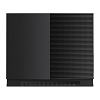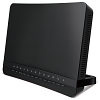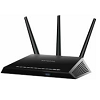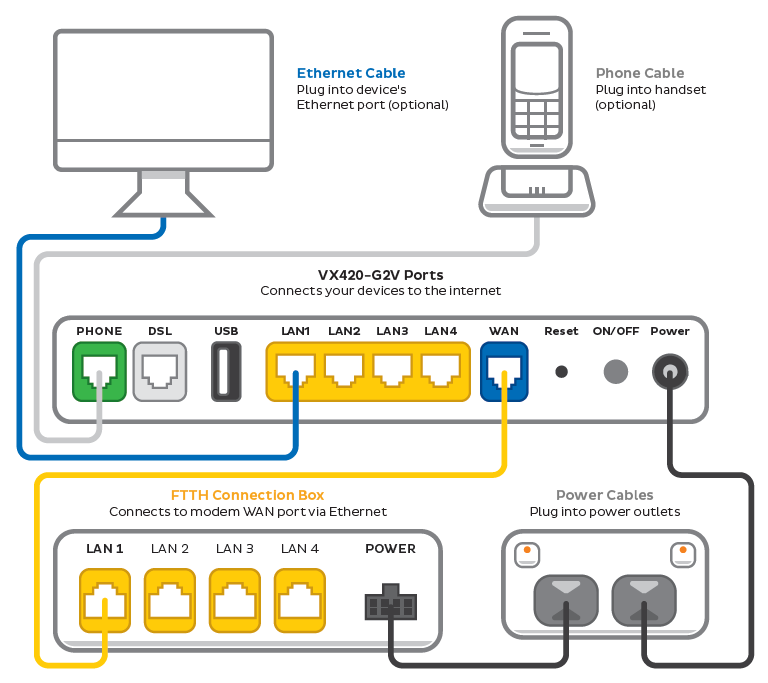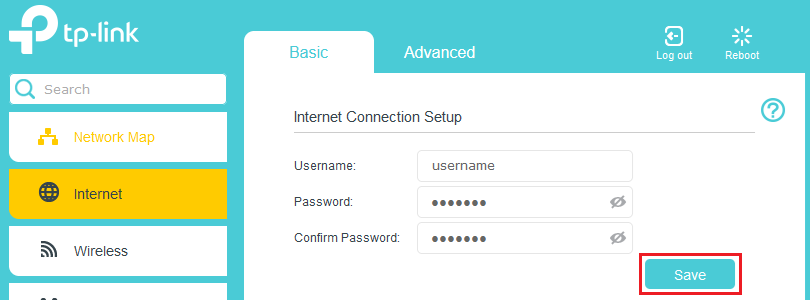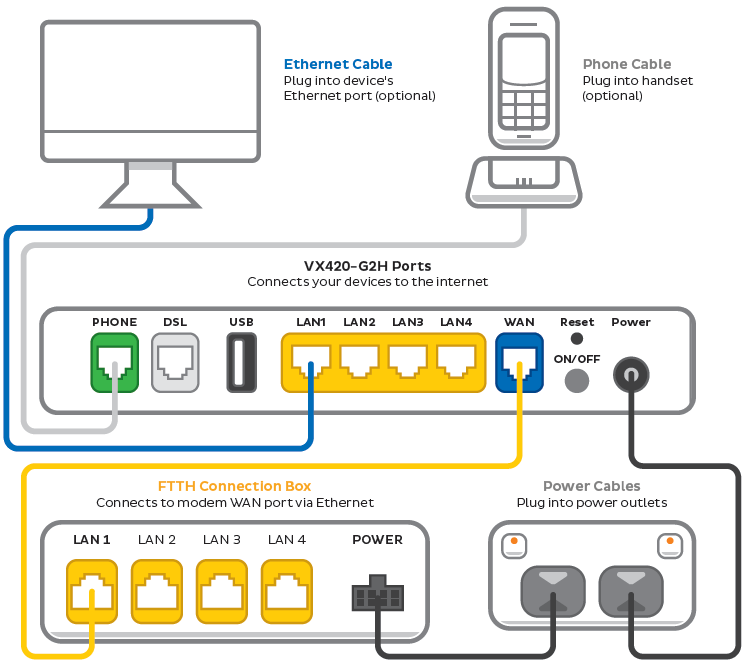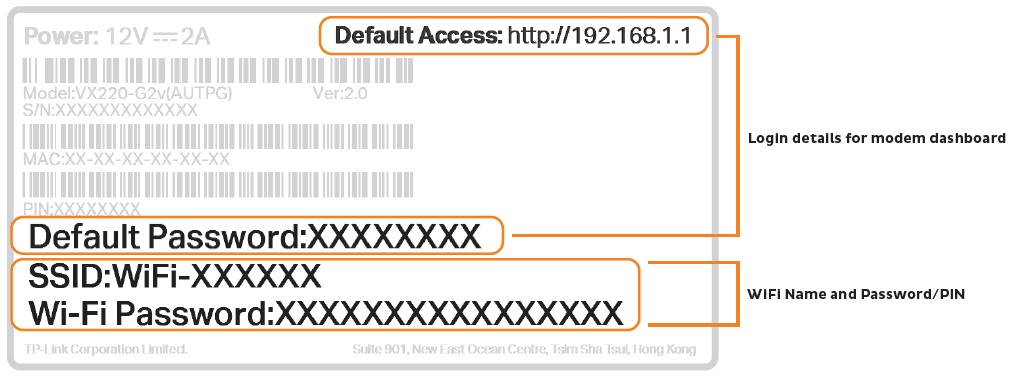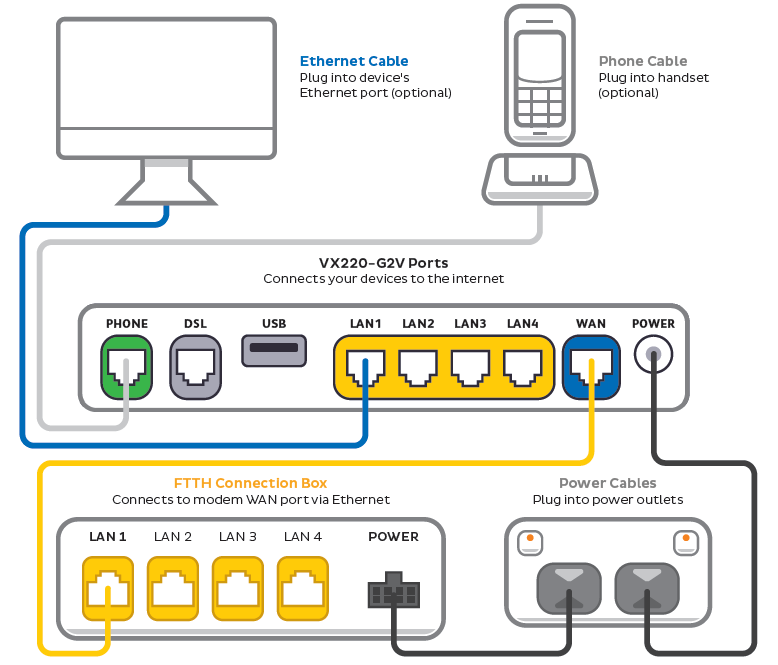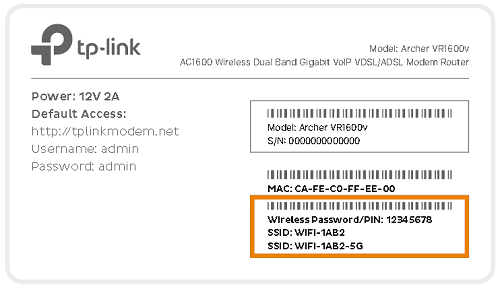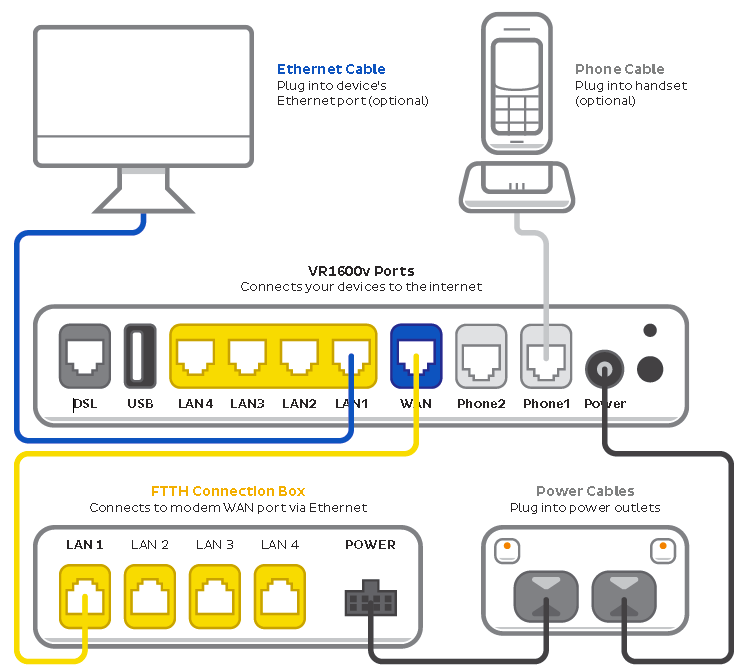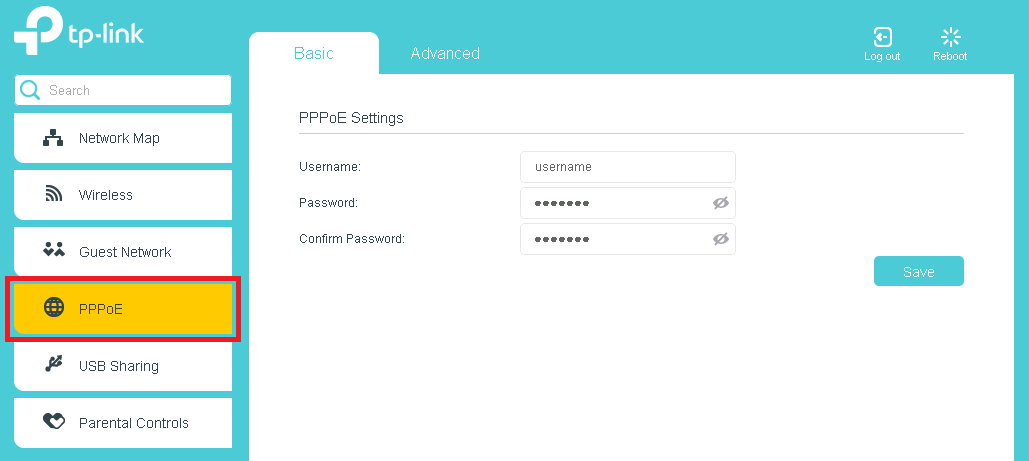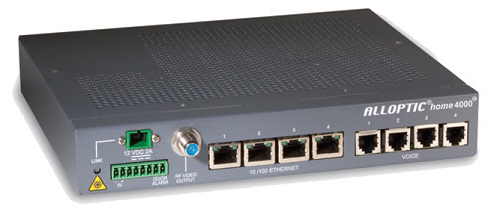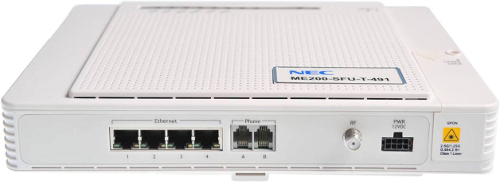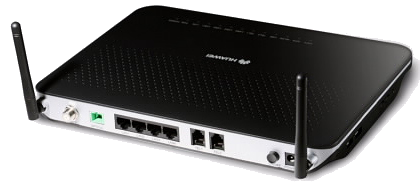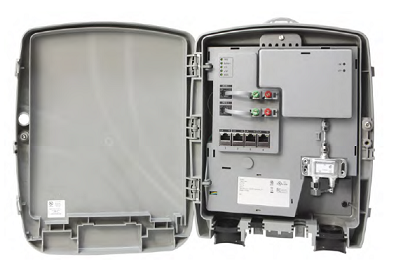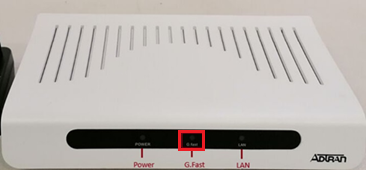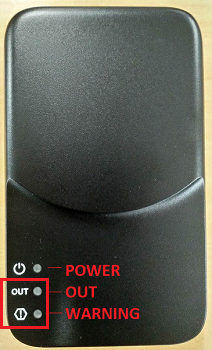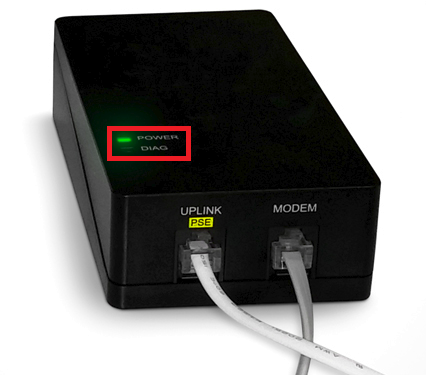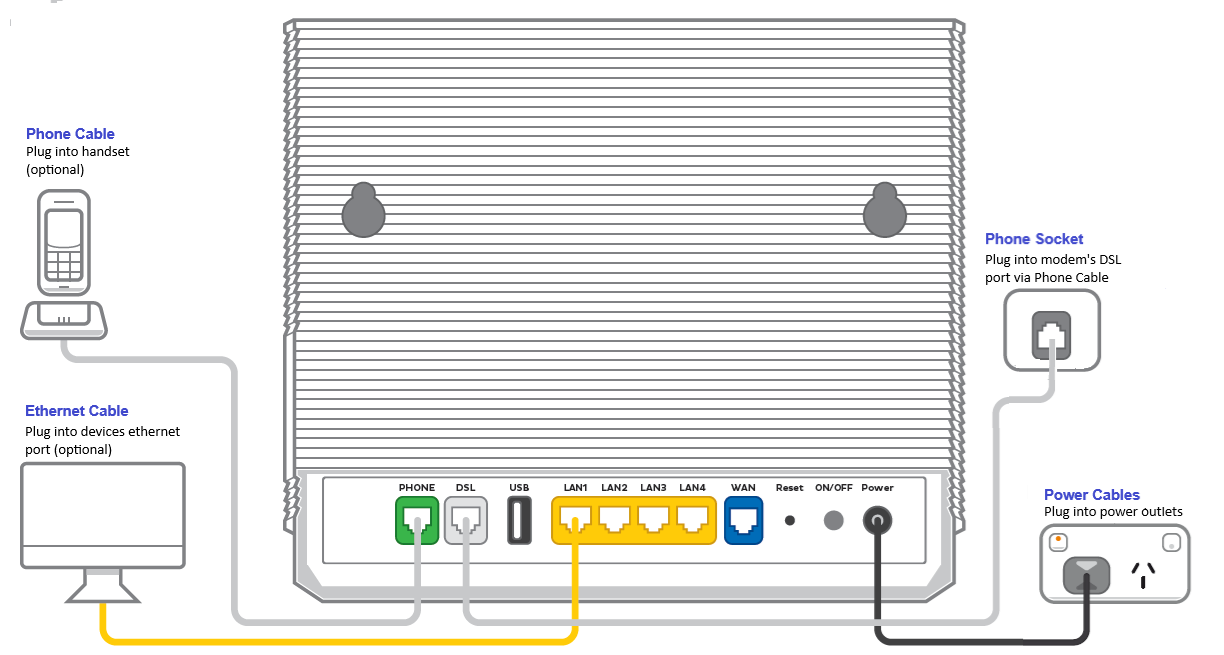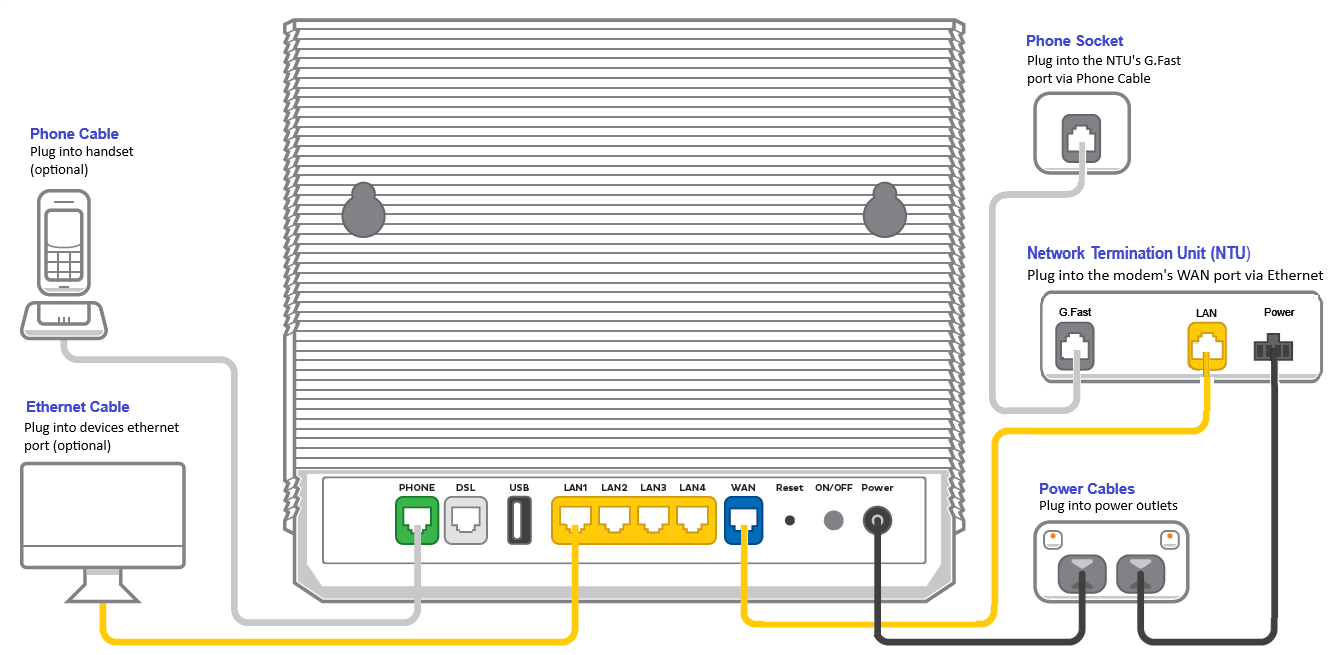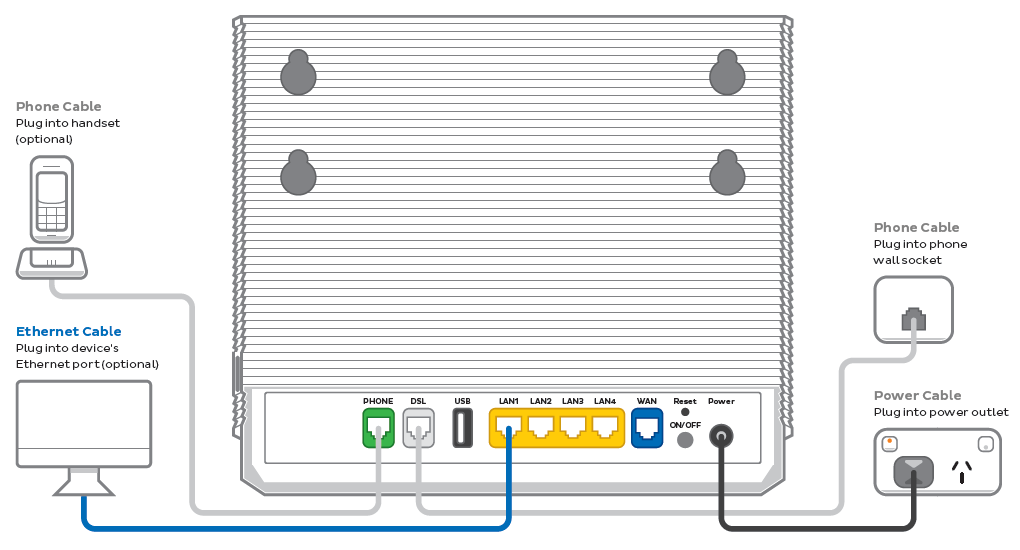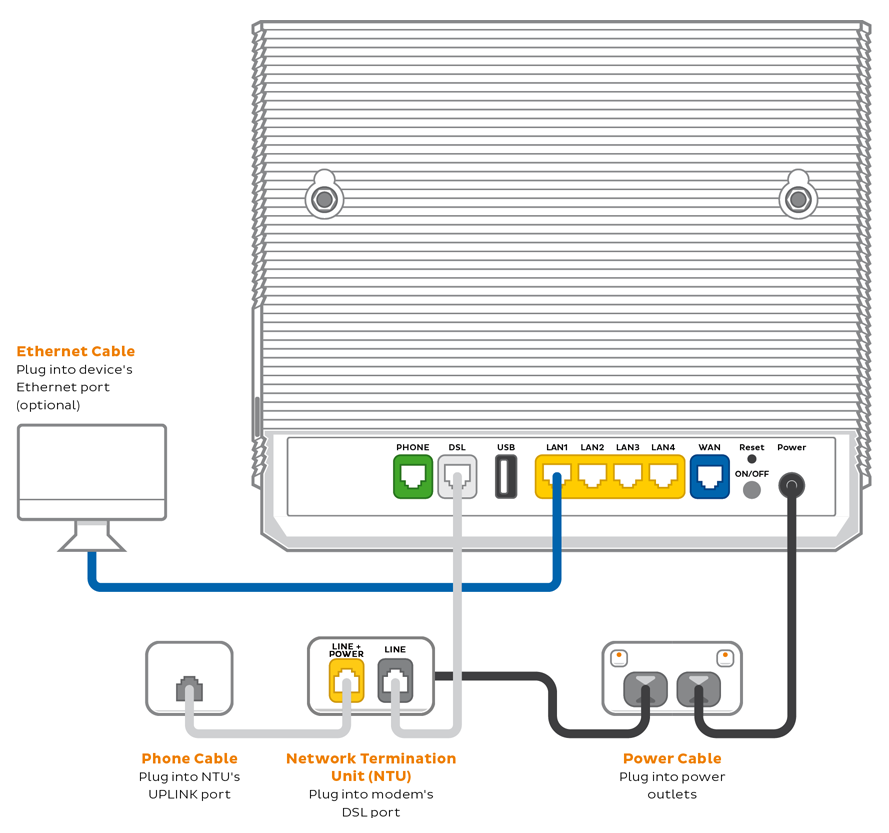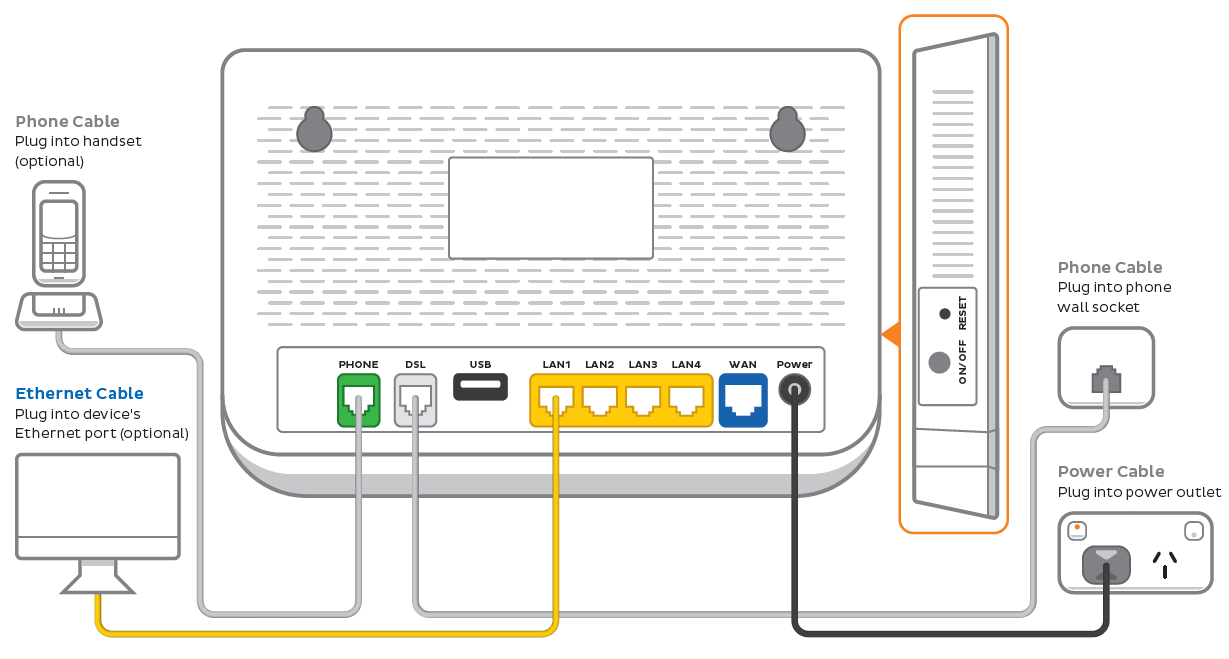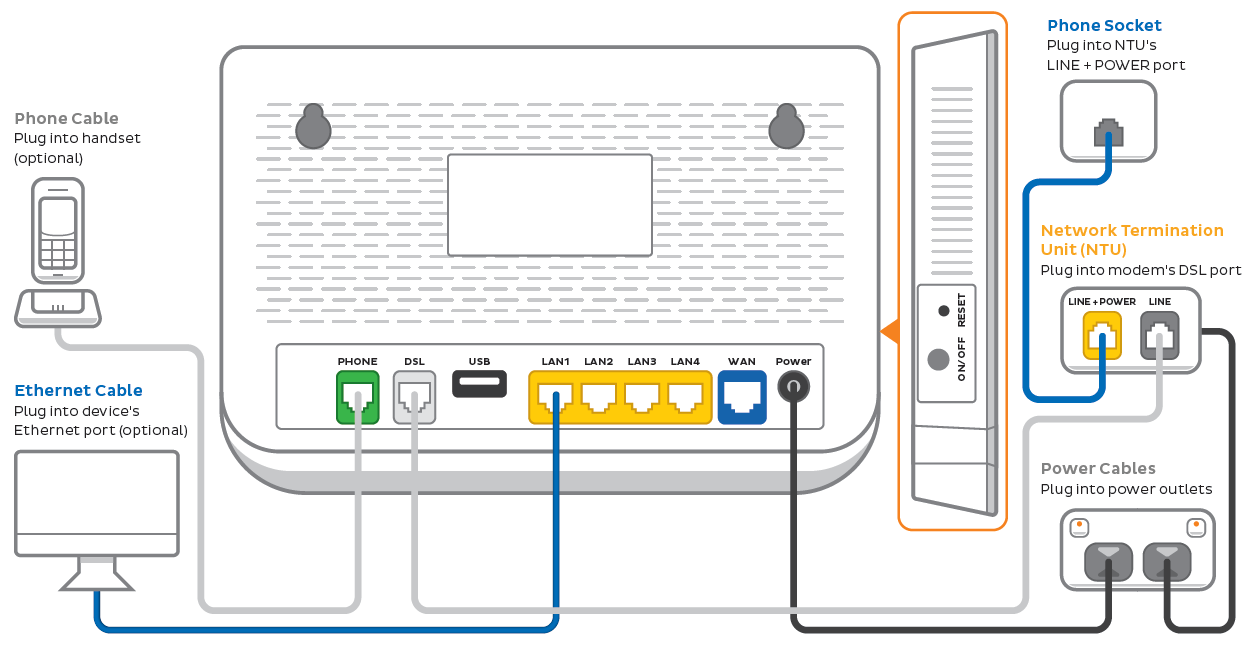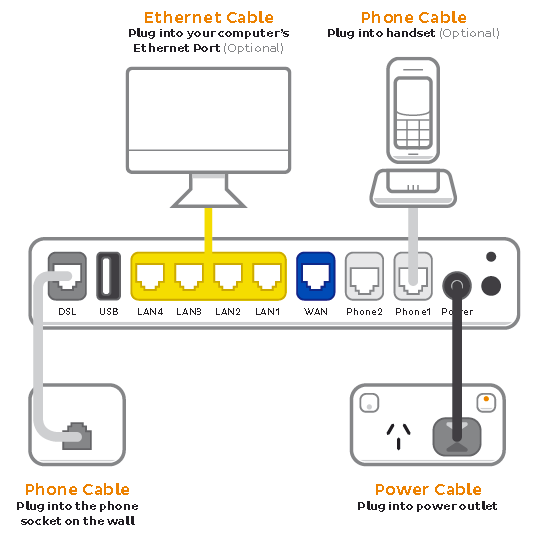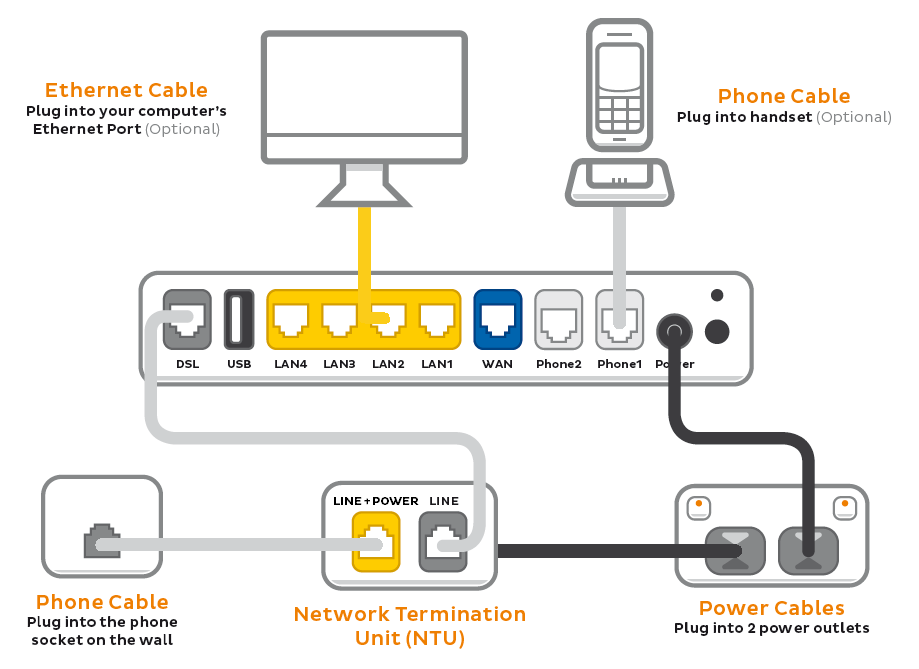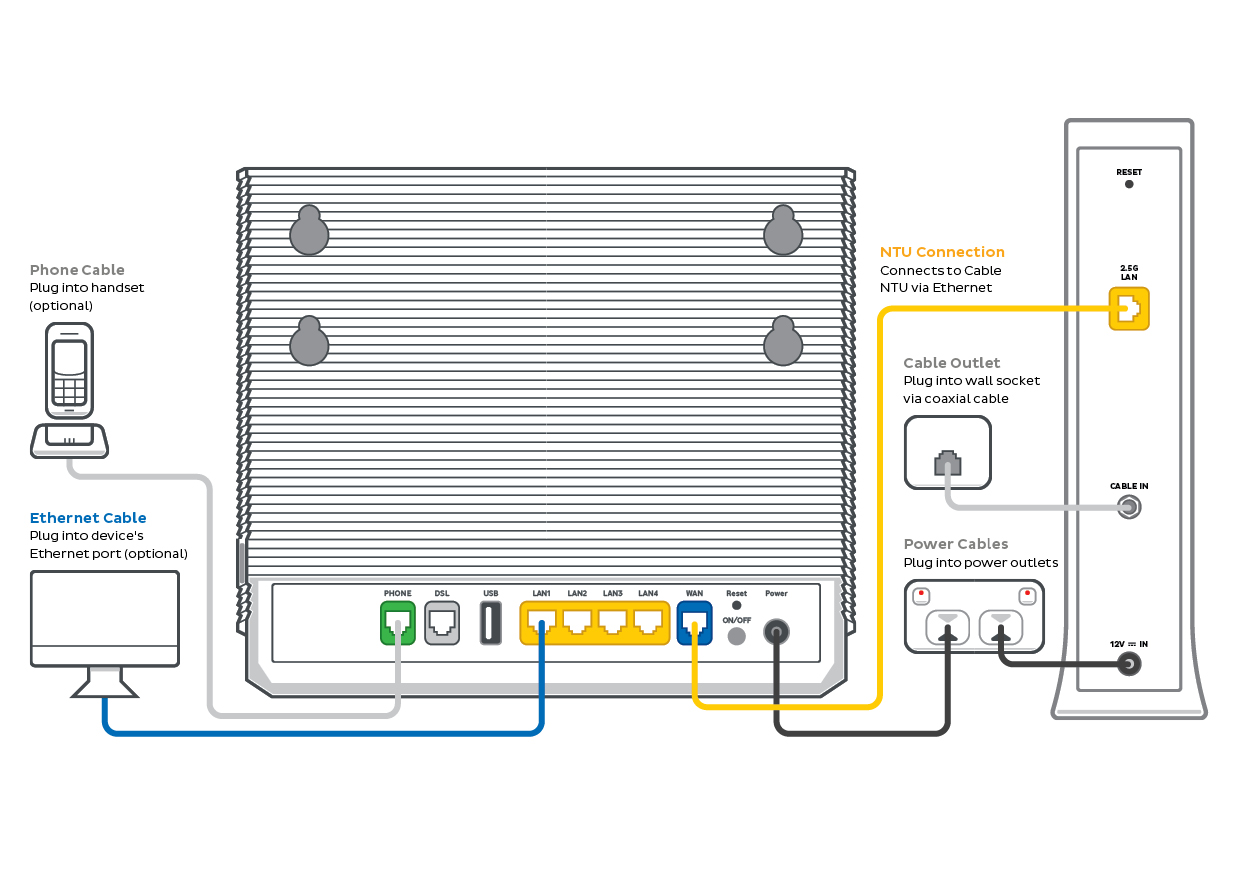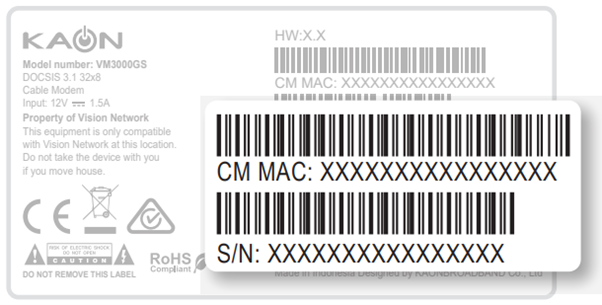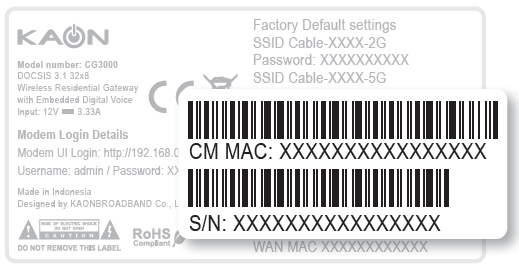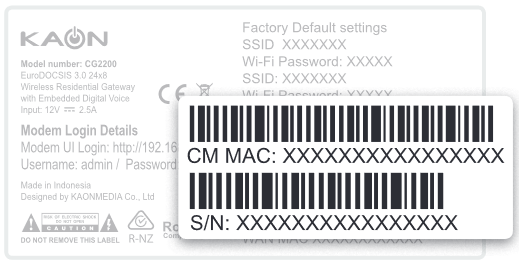Your modem will take care of the hard stuff like internet settings, but we’ll need your help to plug it in. The main cables you need will come in the box, and you can grab extra Ethernet cables from the shops if you need them.
These instructions will work for all iiNet FTTH services, including Opticomm or RedTrain.
Choose your modem to get started:
| Picture | Modem |
|---|---|
| VX420-G2V Modem | |
| Smart Modem Gateway (VX420-G2H) | |
| VX220-G2V Modem | |
| TP-Link VR1600v | |
| Don't have an iiNet modem? See our BYO modem guide. |
How to plug in your VX420-G2V Modem for FTTH
- First, make sure you’ve got a message from us asking you to plug in your modem. We need to get your connection ready on our side first.
- Find your FTTH Connection Box – this is usually installed on the inside of an exterior wall in your home, sometimes in the garage. Some older installations may be in a cabinet on an outside wall. Unplug any old modem from the Connection Box and power outlet.
Examples of connection boxes can be found here. - Use the power cable to connect your modem's Power port to a power outlet and press your modem’s ON/OFF button.
- Use the Ethernet cable to connect your modem's blue WAN port to your Connection Box's LAN1 or Ethernet 1 port.
- You'll find the default Wi-Fi name (SSID) and Wireless password/PIN on your modem's barcode sticker. If you want to change your Wi-Fi name or password, use this guide.
- Your devices will automatically connect to the best Wi-Fi possible. If your Wi-Fi’s running slow, check out Improving Wi-Fi Signal.
- For online gaming or HD/4K streaming, Ethernet is better than Wi-Fi. If you have extra Ethernet cables, you can connect up to 4 devices to your modem’s yellow LAN ports.
- To use your iiNet Netphone service, just plug a handset into your modem’s green Phone port.
- Now it's time to enter your modem settings. On a device that's connected to your modem via Ethernet or Wi-Fi, visit http://192.168.1.1 and log in with the default username admin and default password admin.
If you have custom login details, use those instead. - Select Internet, enter the following settings and hit Save. Allow up to 5 minutes for the new settings to apply.
Username: Your FTTH username (you'll find this in emails about your FTTH service)
Password: Your FTTH password (please use our password reset tool if you've forgotten your password)
Confirm Password: Your FTTH password
- Check your modem's Internet light. If it's green, you're online!
No green light? Call us on 13 22 58 and we can help you out.
How to plug in your Smart Modem Gateway (VX420-G2H) for FTTH
- First, make sure you’ve got a message from us asking you to plug in your modem. We need to get your connection ready on our side first.
- Find your FTTH Connection Box – this is usually installed on the inside of an exterior wall in your home, sometimes in the garage. Some older installations may be in a cabinet on an outside wall. Unplug any old modem from the Connection Box and power outlet.
Examples of connection boxes can be found here. - Use the power cable to connect your modem's Power port to a power outlet and press your modem’s ON/OFF button.
- Use the Ethernet cable to connect your modem's blue WAN port to your Connection Box's LAN1 or Ethernet 1 port.
- You'll find the default Wi-Fi name (SSID) and Wireless password/PIN on your modem's barcode sticker. If you want to change your Wi-Fi name or password, use this guide.
- Your devices will automatically connect to the best Wi-Fi possible. If your Wi-Fi’s running slow, check out Improving Wi-Fi Signal.
- For online gaming or HD/4K streaming, Ethernet is better than Wi-Fi. If you have extra Ethernet cables, you can connect up to 4 devices to your modem’s yellow LAN ports.
- To use your iiNet Netphone service, just plug a handset into your modem’s green Phone port.
- Now it's time to enter your modem settings. On a device that's connected to your modem via Ethernet or Wi-Fi, visit http://192.168.1.1 and log in with the default username admin and default password admin.
If you have custom login details, use those instead. - Select Internet, enter the following settings and hit Save. Allow up to 5 minutes for the new settings to apply.
Username: Your FTTH username (you'll find this in emails about your FTTH service)
Password: Your FTTH password (please use our password reset tool if you've forgotten your password)
Confirm Password: Your FTTH password
- Check your modem's Internet light. If it's green, you're online!
No green light? Call us on 13 22 58 and we can help you out.
How to plug in your VX220-G2V Modem for FTTH
- First, make sure you’ve got a message from us asking you to plug in your modem. We need to get your connection ready on our side first.
- Find your FTTH Connection Box – this is usually installed on the inside of an exterior wall in your home, sometimes in the garage. Some older installations may be in a cabinet on an outside wall. Unplug any old modem from the Connection Box and power outlet.
Examples of connection boxes can be found here. - Use the power cable to connect your modem's Power port to a power outlet and press your modem’s ON/OFF button.
- Use the Ethernet cable to connect your modem's blue WAN port to your Connection Box's LAN1 or Ethernet 1 port.
- You'll find the default Wi-Fi name (SSID) and Wireless password/PIN on your modem's barcode sticker. If you want to change your Wi-Fi name or password, use this guide.
- Your devices will automatically connect to the best Wi-Fi possible. If your Wi-Fi’s running slow, check out Improving Wi-Fi Signal.
- For online gaming or HD/4K streaming, Ethernet is better than Wi-Fi. If you have extra Ethernet cables, you can connect up to 4 devices to your modem’s yellow LAN ports.
- To use your iiNet Netphone service, just plug a handset into your modem’s green Phone port.
- Now it's time to enter your modem settings. On a device that's connected to your modem via Ethernet or Wi-Fi, visit http://192.168.1.1 and log in with the default username admin and default password admin.
If you have custom login details, use those instead. - Select Internet, enter the following settings and hit Save. Allow up to 5 minutes for the new settings to apply.
Username: Your FTTH username (you'll find this in emails about your FTTH service)
Password: Your FTTH password (please use our password reset tool if you've forgotten your password)
Confirm Password: Your FTTH password
- Enter the following settings then hit Save. Allow up to 5 minutes for the new settings to apply.
Username: Your FTTH username (you'll find this in emails about your FTTH service)
Password: Your FTTH password (please use our password reset tool if you've forgotten your password)
Confirm Password: Your FTTH password
- Check your modem's Internet light. If it's blue, you're online!
No blue light? Call us on 13 22 58 and we can help you out.
How to plug in your TP-Link VR1600v Modem for FTTH
- First, make sure you’ve got a message from us asking you to plug in your modem. We need to get your connection ready on our side first.
- Find your FTTH Connection Box – this is usually installed on the inside of an exterior wall in your home, sometimes in the garage. Some older installations may be in a cabinet on an outside wall. Unplug any old modem from the Connection Box and power outlet.
Examples of connection boxes can be found here. - Use the power cable to connect your modem's Power port to a power outlet and press your modem’s Power button.
- Use the Ethernet cable to connect your modem's blue WAN port to your Connection Box's LAN1 or Ethernet 1 port.
- You'll find the default Wi-Fi name (SSID) and Wireless password/PIN on your modem's barcode sticker. If you want to change your Wi-Fi name or password, use this guide.
- Your devices will automatically connect to the best Wi-Fi possible. If your Wi-Fi’s running slow, check out Improving Wi-Fi Signal.
- For online gaming or HD/4K streaming, Ethernet is better than Wi-Fi. If you have extra Ethernet cables, you can connect up to 4 devices to your modem’s yellow LAN ports.
- To use your iiNet Netphone service, just plug a handset into your modem’s grey Phone1 port.
- Now it's time to enter your modem settings. On a device that's connected to your modem via Ethernet or Wi-Fi, visit http://192.168.1.1 and log in with the default username admin and default password admin.
If you have custom login details, use those instead. - Select PPPoE, enter the following settings and hit Save. Allow up to 5 minutes for the new settings to apply.
Username: Your FTTH username (you'll find this in emails about your FTTH service)
Password: Your FTTH password (please use our password reset tool if you've forgotten your password)
Confirm Password: Your FTTH password
- Check your modem's Internet light. If it's green, you're online!
No green light? Call us on 13 22 58 and we can help you out.
FTTH Connection Box examples
ALLOPTIC home 4000
NEC ME200
Huawei HG8247
Dasan H690R
Here's everything you need to know about iiNet Ultra Broadband Fibre to the Building (FTTB) services on the Vision network.
Select one of the links below to jump to a query:
- Where is Ultra Broadband FTTB available?
- How is Ultra Broadband FTTB connected?
- What do I need for an Ultra Broadband FTTB connection?
- How does FTTB Phone work?
- How long does it take to get connected to Ultra Broadband FTTB?
- Can I use smart wiring with Ultra Broadband FTTB?
- Will my medical alarm, security alarm, EFTPOS machine or fax machine work on Ultra Broadband FTTB?
Where is Ultra Broadband FTTB available?
iiNet Ultra Broadband FTTB is available in select buildings nationwide. You can check your address on our website.
How is Ultra Broadband FTTB connected?
Fibre optic cable will run to your building's Main Distribution Frame (MDF), which is typically in the basement or a locked telecommunications cabinet. From there, copper wiring will run to a wall socket in each unit within the building.
What do I need for an Ultra Broadband FTTB connection?
We'll send you a modem when you order Ultra Broadband FTTB. BYO modems aren't supported on Ultra Broadband FTTB but you can connect your own Wi-Fi router to your iiNet modem if you'd like.
Some connections need a Network Termination Unit (NTU), which is an extra device your modem plugs into before plugging into the wall. If you need one, we'll deliver it with your iiNet modem.
Note: If you move out, please leave your NTU behind. It won't be useful at your new place.
You'll also need a phone to plug into your modem if you want to use your iiNet FTTB Phone service.
How does FTTB Phone work?
FTTB Phone is a VoIP (Voice over Internet Protocol) phone service that uses your internet connection to make phone calls.
How long does it take to get connected to Ultra Broadband FTTB?
Most connections are done within 10 business days. It may take up to 20 business days if it's the first time your address has been connected to Ultra Broadband FTTB, or if an installer needs to come to your place.
If you do need an installation, we'll book the earliest available appointment by default - or you can choose a later date if it's more convenient.
Can I use smart wiring with Ultra Broadband FTTB?
Smart wiring is internal Ethernet cabling at your house. It means you have Ethernet wall sockets to connect devices to your nbn modem without running Ethernet cables along the floor or under doors. It's a good investment for heavy internet uses, or larger homes that don't get enough coverage from a standard Wi-Fi signal.
You can use smart wiring with Ultra Broadband FTTB, but it won't be included with your installation. You'll need to hire a registered cabler to have smart wiring installed.
Note: Existing smart wiring may need to be re-wired to work with Ultra Broadband FTTB.
Will my medical alarm, security alarm, EFTPOS machine or fax machine work on Ultra Broadband FTTB?
Many devices that work over phone lines can work on Ultra Broadband FTTB, but you need to contact your service provider to make sure before you switch. You may need to get a different type of product that will work on Ultra Broadband FTTB.
Note: iiNet does not offer a Priority Assistance service. If you have Priority Assistance or believe you may be eligible, please consider this before ordering.
If your Ultra Broadband FTTB service is having dropouts, it means your internet will go offline and come back online intermittently. These steps will help you identify the issue.
- Your service may just be affected by an outage or planned maintenance. You can check your address on our Network Status page.
If there is an outage or planned maintenance, the results will give you an estimated fix time. - Do you have any devices connected to your modem with an Ethernet cable? If these devices stay connected when devices on Wi-Fi drop out, switch to troubleshooting WiFi Dropouts.
- Find your modem and make sure the cables are plugged in securely and not damaged. Our setup guide will show you how to plug in.
You’ll need to replace any broken or chewed cables. Not all setups have a Network Termination Unit (NTU). - If you have a Network Termination Unit (NTU) and you notice any of these status light behaviours, please call us on 13 22 58.
Adtran® 422G Gfast NTU - Flashing green G.Fast light
The phone cable must not be longer than 1 metre.
LEA Networks NTU - Flashing green OUT or Warning light
Power/DIAG NTU - Red DIAG light - Still getting dropouts? Please call us on 13 22 58 and we’ll help you.
If your Ultra Broadband FTTB service is offline, you won’t be able to visit a website, browse, stream, or download. Email and any other services that use the internet will not work. These steps will help you identify the issue.
- Your service may just be affected by an outage or planned maintenance. You can check your address on our Network Status page.
If there is an outage or planned maintenance, the results will give you an estimated fix time. - Find your modem and make sure the cables are plugged in securely and not damaged. Our setup guide will show you how to plug in.
You’ll need to replace any broken or chewed cables. Not all setups have a Network Termination Unit (NTU).
- Turn off the your modem's power outlet for at least 10 seconds.
- Turn the outlet back on and wait for your modem’s Internet light to come on, then see if you can visit a website.
- If you have a Network Termination Unit (NTU) and you notice any of these status light behaviours, please call us on 13 22 58.
Adtran® 422G Gfast NTU - Flashing green G.Fast light
The phone cable must not be longer than 1 metre.
LEA Networks NTU - Flashing green OUT or Warning light
Power/DIAG NTU - Red DIAG light - Do you have any devices connected to your modem with an Ethernet cable? If these devices can visit a website but devices on Wi-Fi can’t, switch to troubleshooting Wi-Fi No Connection.
- If you can view websites on some devices but not others, even when they’re both connected the same way, you may need to fix some browser settings. Check out our guide on Browsing issues.
- Still can't get online? Please call us on 13 22 58 and we’ll help you.
If your Ultra Broadband FTTB service is running slowly, these steps will help you identify the issue.
-
Your service may just be affected by planned maintenance. You can check your address on our Network Status page.
If there is planned maintenance, the results will give you an estimated fix time. -
Find your modem and turn off its power outlet for at least 10 seconds.
-
Turn the outlet back on and wait for your modem’s Internet light to come on, then run a speed test.
- Do you have any devices connected to your modem with an Ethernet cable? If speeds on these devices are fine but devices on WiFi are slow, switch to Troubleshooting WiFi speed.
-
Make sure that the device you’re using to run speeds tests is the only one connected to your modem. Unplug all other devices from your modem’s Ethernet ports and turn off other devices that are connected to the Wi-Fi.
-
On your one device, close all other apps using the internet, then run a speed test.
-
If your speed has improved on a single device, you may be running more devices or apps than your connection can handle at the same time. Some apps run in the background - you should close them if you don't need them.
- If you use Windows, you can press CTRL+ALT+DELETE on your keyboard and then open the Task Manager to see what's running.
- If you have a Mac, you can see all the apps running in the Dock at the bottom of the screen. -
Make sure your modem’s Ethernet cables are in good condition, with “CAT6” or “CAT5e” printed on them.
Older Cat5 Ethernet cables are not recommended for nbn services. You’ll need to replace any broken or chewed cables.
-
Run a scan on your antivirus/anti-malware software. If your software includes any firewalls, temporarily disable them and run a speed test to see if they’re slowing down your internet.
If any infections are detected, make sure they are quarantined and removed. Contact your software’s Customer Support if you need help.
-
Still getting slow speeds? Please call us on 13 22 58 and we’ll help you.
Your modem will take care of the hard stuff like internet settings, but we’ll need your help to plug it in. The main cables you need will come in the box, and you can grab extra Ethernet cables from the shops if you need them.
Note: Some homes will have a Network Termination Unit (NTU). If your place has never been connected to FTTB before, an NTU will be delivered with your modem if you need one.
Choose your modem (with or without NTU) to get started:
VX420-G2V Modem
- First, make sure you’ve got a message from us asking you to plug in your modem. We need to get your connection ready on our side first.
- Find your phone wall socket – you probably already have a modem plugged in from your last internet service. Unplug any old modem from the phone wall socket and power outlet.
- Use the power cable to connect your modem's Power port to a power outlet.
- Use the phone cable to connect your modem’s grey DSL port to your phone wall socket.
- Turn on the power outlet and press your modem’s ON/OFF button.
- Leave your modem alone for 30 minutes while it runs through its automatic setup.
- Check the Internet light on your modem. If it’s green, you’re online and you can start connecting your devices.
No green light? Call us on 13 22 58 and we can help you out. - You'll find the default Wi-Fi name (SSID) and Wireless password/PIN on your modem's barcode sticker. If you want to change your Wi-Fi name or password, use this guide.
- Your devices will automatically connect to the best Wi-Fi possible. If your Wi-Fi’s running slow, check out Improving Wi-Fi Signal.
- For online gaming or HD/4K streaming, Ethernet is better than Wi-Fi. If you have extra Ethernet cables, you can connect up to 4 devices to your modem’s yellow LAN ports.
- To use your FTTB Phone service, just plug a handset into your modem’s green Phone port.
- You’re now good to go.
If you don’t want to keep your old modem, see if your local council has any eWaste recycling facilities.
VX420-G2V Modem with a Network Termination Unit (NTU)
- First, make sure you’ve got a message from us asking you to plug in your modem. We need to get your connection ready on our side first.
- Find your phone wall socket – you probably already have a modem plugged in from your last internet service. Unplug any old modem from the phone wall socket and power outlet.
- Use the power cables to connect the Power port on your modem and NTU to power outlets.
- Use one phone cable to connect your modem’s grey DSL port to your NTU's LINE or LAN port.
Older NTUs may have a MODEM port. Learn more. - Use the other phone cable to connect your your NTU's LINE + POWER or G.Fast port to your phone wall socket.
Older NTUs may have an UPLINK port. Learn more. - Turn on the power outlet and press your modem’s ON/OFF button.
- Leave your modem alone for 30 minutes while it runs through its automatic setup.
- Check the Internet light on your modem. If it’s green, you’re online and you can start connecting your devices.
No green light? Call us on 13 22 58 and we can help you out. - You'll find the default Wi-Fi name (SSID) and Wireless password/PIN on your modem's barcode sticker. If you want to change your Wi-Fi name or password, use this guide.
- Your devices will automatically connect to the best Wi-Fi possible. If your Wi-Fi’s running slow, check out Improving Wi-Fi Signal.
- For online gaming or HD/4K streaming, Ethernet is better than Wi-Fi. If you have extra Ethernet cables, you can connect up to 4 devices to your modem’s yellow LAN ports.
- To use your FTTB Phone service, just plug a handset into your modem’s green Phone port.
- You’re now good to go.
If you don’t want to keep your old modem, see if your local council has any eWaste recycling facilities.
Smart Modem Gateway (VX420-G2H)
Please note: If you choose to re-use your Smart Modem Gateway for Ultra FTTB, your FTTB Phone VoIP service will not work.
- First, make sure you’ve got a message from us asking you to plug in your modem. We need to get your connection ready on our side first.
- Find your phone wall socket – you probably already have a modem plugged in from your last internet service. Unplug any old modem from the phone wall socket and power outlet.
- Use the power cable to connect your modem's Power port to a power outlet.
- Use the phone cable to connect your modem’s grey DSL port to your phone wall socket.
- Turn on the power outlet and press your modem’s ON/OFF button.
- Leave your modem alone for 30 minutes while it runs through its automatic setup.
- Check the Internet light on your modem. If it’s green, you’re online and you can start connecting your devices.
No green light? Call us on 13 22 58 and we can help you out. - You'll find the default Wi-Fi name (SSID) and Wireless password/PIN on your modem's barcode sticker. If you want to change your Wi-Fi name or password, use this guide.
- Your devices will automatically connect to the best Wi-Fi possible. If your Wi-Fi’s running slow, check out Improving Wi-Fi Signal.
- For online gaming or HD/4K streaming, Ethernet is better than Wi-Fi. If you have extra Ethernet cables, you can connect up to 4 devices to your modem’s yellow LAN ports.
- You’re now good to go.
If you don’t want to keep your old modem, see if your local council has any eWaste recycling facilities.
Smart Modem Gateway (VX420-G2H) with a Network Termination Unit (NTU)
Please note: If you choose to re-use your Smart Modem Gateway for Ultra FTTB, your FTTB Phone VoIP service will not work.
- First, make sure you’ve got a message from us asking you to plug in your modem. We need to get your connection ready on our side first.
- Find your phone wall socket – you probably already have a modem plugged in from your last internet service. Unplug any old modem from the phone wall socket and power outlet.
- Use the power cables to connect the Power port on your modem and NTU to power outlets.
- Use one phone cable to connect your modem’s grey DSL port to your NTU's LINE or LAN port.
Older NTUs may have a MODEM port. Learn more. - Use the other phone cable to connect your your NTU's LINE + POWER or G.Fast port to your phone wall socket.
Older NTUs may have an UPLINK port. Learn more. - Turn on the power outlet and press your modem’s ON/OFF button.
- Leave your modem alone for 30 minutes while it runs through its automatic setup.
- Check the Internet light on your modem. If it’s green, you’re online and you can start connecting your devices.
No green light? Call us on 13 22 58 and we can help you out. - You'll find the default Wi-Fi name (SSID) and Wireless password/PIN on your modem's barcode sticker. If you want to change your Wi-Fi name or password, use this guide.
- Your devices will automatically connect to the best Wi-Fi possible. If your Wi-Fi’s running slow, check out Improving Wi-Fi Signal.
- For online gaming or HD/4K streaming, Ethernet is better than Wi-Fi. If you have extra Ethernet cables, you can connect up to 4 devices to your modem’s yellow LAN ports.
- You’re now good to go.
If you don’t want to keep your old modem, see if your local council has any eWaste recycling facilities.
VX220-G2V Modem
- First, make sure you’ve got a message from us asking you to plug in your modem. We need to get your connection ready on our side first.
- Find your phone wall socket – you probably already have a modem plugged in from your last internet service. Unplug any old modem from the phone wall socket and power outlet.
- Use the power cable to connect your modem's Power port to a power outlet.
- Use the phone cable to connect your modem’s grey DSL port to your phone wall socket.
- Turn on the power outlet and press your modem’s ON/OFF button.
- Leave your modem alone for 30 minutes while it runs through its automatic setup.
- Check the Internet light on your modem. If it’s blue, you’re online and you can start connecting your devices.
No blue light? Call us on 13 22 58 and we can help you out. - You'll find the default Wi-Fi name (SSID) and Password on your modem's barcode sticker. If you want to change your Wi-Fi name or password, use this guide.
- Your devices will automatically connect to the best Wi-Fi possible. If your Wi-Fi’s running slow, check out Improving Wi-Fi Signal.
- For online gaming or HD/4K streaming, Ethernet is better than Wi-Fi. If you have extra Ethernet cables, you can connect up to 4 devices to your modem’s yellow LAN ports.
- To use your FTTB Phone service, just plug a handset into your modem’s green Phone port.
- You’re now good to go.
If you don’t want to keep your old modem, see if your local council has any eWaste recycling facilities.
VX220-G2V Modem with a Network Termination Unit (NTU)
- First, make sure you’ve got a message from us asking you to plug in your modem. We need to get your connection ready on our side first.
- Find your phone wall socket – you probably already have a modem plugged in from your last internet service. Unplug any old modem from the phone wall socket and power outlet.
- Use the power cables to connect the Power port on your modem and NTU to power outlets.
- Use one phone cable to connect your modem’s grey DSL port to your NTU's LINE or LAN port.
Older NTUs may have a MODEM port. Learn more. - Use the other phone cable to connect your your NTU's LINE + POWER or G.Fast port to your phone wall socket.
Older NTUs may have an UPLINK port. Learn more. - Turn on the power outlet and press your modem’s ON/OFF button.
- Leave your modem alone for 30 minutes while it runs through its automatic setup.
- Check the Internet light on your modem. If it’s blue, you’re online and you can start connecting your devices.
No blue light? Call us on 13 22 58 and we can help you out. - You'll find the default Wi-Fi name (SSID) and Password on your modem's barcode sticker. If you want to change your Wi-Fi name or password, use this guide.
- Your devices will automatically connect to the best Wi-Fi possible. If your Wi-Fi’s running slow, check out Improving Wi-Fi Signal.
- For online gaming or HD/4K streaming, Ethernet is better than Wi-Fi. If you have extra Ethernet cables, you can connect up to 4 devices to your modem’s yellow LAN ports.
- To use your FTTB Phone service, just plug a handset into your modem’s green Phone port.
- You’re now good to go.
If you don’t want to keep your old modem, see if your local council has any eWaste recycling facilities.
TP-Link VR1600v
- First, make sure you’ve got a message from us asking you to plug in your modem. We need to get your connection ready on our side first.
- Find your phone wall socket – you probably already have a modem plugged in from your last internet service. Unplug any old modem from the phone wall socket and power outlet.
- Use the power cable to connect your modem's Power port to a power outlet.
- Use the phone cable to connect your modem’s grey DSL port to your phone wall socket.
- Turn on the power outlet and press your modem’s Power button.
- Leave your modem alone for 30 minutes while it runs through its automatic setup.
- Check the Internet light on your modem. If it’s green, you’re online and you can start connecting your devices.
No green light? Call us on 13 22 58 and we can help you out. - You'll find the default Wi-Fi name (SSID) and Wireless password/PIN on your modem's barcode sticker. If you want to change your Wi-Fi name or password, use this guide.
Your devices will automatically connect to the best Wi-Fi possible. If your Wi-Fi’s running slow, check out Improving Wi-Fi Signal. - For online gaming or HD/4K streaming, Ethernet is better than Wi-Fi. If you have extra Ethernet cables, you can connect up to 4 devices to your modem’s yellow LAN ports.
- To use your FTTB Phone service, just plug a handset into your modem’s grey Phone1 port.
- You’re now good to go.
If you don’t want to keep your old modem, see if your local council has any eWaste recycling facilities.
TP-Link VR1600v with a Network Termination Unit (NTU)
- First, make sure you’ve got a message from us asking you to plug in your modem. We need to get your connection ready on our side first.
- Find your phone wall socket – you probably already have a modem plugged in from your last internet service. Unplug any old modem from the phone wall socket and power outlet.
- Use the power cables to connect the Power port on your modem and NTU to power outlets.
- Use one phone cable to connect your modem’s grey DSL port to your NTU's LINE or LAN port.
Older NTUs may have a MODEM port. Learn more. - Use the other phone cable to connect your your NTU's LINE + POWER or G.Fast port to your phone wall socket.
Older NTUs may have an UPLINK port. Learn more. - Turn on the power outlet and press your modem’s ON/OFF button.
- Leave your modem alone for 30 minutes while it runs through its automatic setup.
- Check the Internet light on your modem. If it’s green, you’re online and you can start connecting your devices.
No green light? Call us on 13 22 58 and we can help you out. - You'll find the default Wi-Fi name (SSID) and Wireless password/PIN on your modem's barcode sticker. If you want to change your Wi-Fi name or password, use this guide.
- Your devices will automatically connect to the best Wi-Fi possible. If your Wi-Fi’s running slow, check out Improving Wi-Fi Signal.
- For online gaming or HD/4K streaming, Ethernet is better than Wi-Fi. If you have extra Ethernet cables, you can connect up to 4 devices to your modem’s yellow LAN ports.
- To use your FTTB Phone service, just plug a handset into your modem’s grey Phone1 port.
- You’re now good to go.
If you don’t want to keep your old modem, see if your local council has any eWaste recycling facilities.
Here's everything you need to know about iiNet Ultra Broadband Cable.
Select one of the links below to jump to a query:
- Where is Ultra Broadband Cable available?
- What do I need for Ultra Broadband Cable?
- Will Ultra Broadband Cable be replaced by the nbn®?
- What happens when Ultra Broadband Cable is installed?
Where is Ultra Broadband Cable available?
The iiNet Ultra Broadband Cable network is available in select areas across Geelong, Mildura, and Ballarat. The easiest way to confirm availability is to check your address on our website.
What do I need for Ultra Broadband Cable?
- Cable NTU
The Network Termination Unit (NTU) is a connection box that’s delivered by the Cable installer. These are required for all Cable connections from 14 May 2025 onwards.
- Cable modem
We include a Wi-Fi Cable modem with every Cable order – once it arrives from our warehouse, you can plug it in into the NTU.
- Phone
To use your Netphone VoIP service, you'll need a phone to plug into your Cable modem.
Will Ultra Broadband Cable be replaced by the nbn®?
iiNet Ultra Broadband Cable will not be affected by the nbn rollout. It is a future-ready network that delivers a high performance alternative to the nbn.
If you are an existing Cable customer, please ignore any nbn notifications that you may receive telling you that your broadband will be disconnected as part of the nbn rollout. You don’t have to switch to the nbn.
What happens when Ultra Broadband Cable is installed?
If a Cable installer is required to visit your premises, we'll be in touch to book a suitable appointment with you. The installer will complete your connection and run a test to make sure you can get online.
Note: If your iiNet Cable modem hasn't been delivered before your Cable installation, don't worry. The technician will use their own modem to test the connection, and you can plug in your iiNet Cable modem once it's delivered.
If your Ultra Broadband Cable service is having dropouts, it means your internet will go offline and come back online intermittently. These steps will help you identify the issue.
- Your service may just be affected by an outage or planned maintenance. You can check your address on our Network Status page.
If there is an outage or planned maintenance, the results will give you an estimated fix time. -
Do you have any devices connected to your modem with an Ethernet cable? If these devices stay connected when devices on Wi-Fi drop out, switch to troubleshooting Wi-Fi Dropouts.
-
Find your Cable modem and make sure the cables are plugged in securely and not damaged. Our setup guide will show you how to plug in.
You’ll need to replace any broken or chewed cables.
-
Still getting dropouts? Please call us on 13 22 58 and we’ll help you.
If your Ultra Broadband Cable service is offline, you won’t be able to visit a website, browse, stream, or download. Email and any other services that use the internet will not work. These steps will help you identify the issue.
- Your service may just be affected by an outage or planned maintenance. You can check your address on our Network Status page.
If there is an outage or planned maintenance, the results will give you an estimated fix time. -
Find your Cable modem and make sure the cables are plugged in securely and not damaged. Our setup guide will show you how to plug in.
You’ll need to replace any broken or chewed cables.
-
Turn off your modem’s power outlet for at least 10 seconds.
-
Turn the outlet back on and wait for your modem’s Internet light to come on, then see if you can visit a website.
Do you have any devices connected to your modem with an Ethernet cable? If these devices can visit a website but devices on Wi-Fi can’t, switch to troubleshooting Wi-Fi No Connection.
- If you can view websites on some devices but not others, even when they’re both connected the same way, you may need to fix some browser settings. Check out our guide on Browsing issues.
- Still can't get online? Please call us on 13 22 58 and we’ll help you. To investigate your connection issue, we'll need the Serial Number (S/N) and CMAC Number for your Cable NTU or modem barcode sticker:
Example: VM3000GS NTU
Example: CG3000 Modem
Example: CG2200 Modem
Example: EPC3940L Modem
If your Ultra Broadband Cable service is running slowly, these steps will help you identify the issue.
- Your service may just be affected by planned maintenance. You can check your address on our Network Status page.
If there is planned maintenance, the results will give you an estimated fix time. - Find your Cable modem and turn off its power outlet for at least 10 seconds.
-
Turn the outlet back on and wait for your modem’s Internet light to come on, then run a speed test.
-
Do you have any devices connected to your modem with an Ethernet cable? If speeds on these devices are fine but devices on Wi-Fi are slow, switch to Troubleshooting Wi-Fi speed.
-
Make sure that the device you’re using to run speeds tests is the only one connected to your modem. Unplug all other devices from your modem’s Ethernet ports and turn off other devices that are connected to the Wi-Fi.
-
On your one device, close all other apps using the internet, then run a speed test.
-
If your speed has improved on a single device, you may need to upgrade your Cable plan to get enough bandwidth to support more apps or devices.
You can change your plan in Toolbox or call us on 13 19 17.
-
Make sure your modem’s Ethernet cables are in good condition, with “CAT6” or “CAT5e” printed on them.
Older Cat5 Ethernet cables are not recommended for Cable services. You’ll need to replace any broken or chewed cables.
-
Run a scan on your antivirus/anti-malware software. If your software includes any firewalls, temporarily disable them and run a speed test to see if they’re slowing down your internet.
If any infections are detected, make sure they are quarantined and removed. Contact your software’s Customer Support if you need help.
-
Still getting slow speeds? Please call us on 13 22 58 and we’ll help you.
